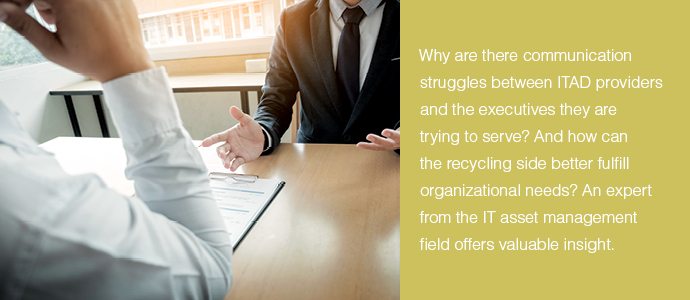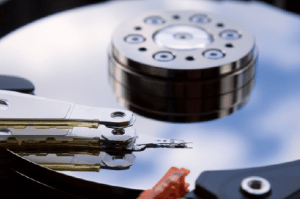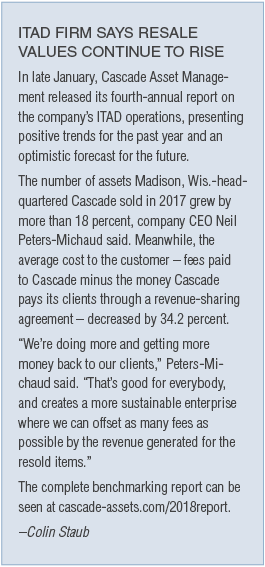
This article originally appeared in the March 2018 issue of E-Scrap News. Subscribe today for access to all print content.
In conversations I had with electronics recycling professionals at industry conferences over the last year, I often heard complaints when the discussion turned to enterprise clients. Typically, the frustration from e-scrap executives sounded something like this: “The IT person I have to work with is clueless about the e-scrap industry.”
I teach IT asset disposition management to IT professionals on a regular basis for the International Association of Information Technology Asset Management (IAITAM). So I was surprised to hear reuse and recycling leaders voice so much displeasure about the lack of knowledge being displayed by their organizational counterparts.
Through my work, I’ve come to see that many companies and institutions that bid out contracts for IT asset disposition (ITAD) services often employ very knowledgeable people internally who have a keen interest in mitigating the risks associated with handling used electronics generated by their teams.
To get a better understanding of the disconnect between ITAD providers and clients, I sent out a questionnaire to IT professionals who had participated in one of my recent ITAD training classes to gain an insider’s view of the organizational side of the relationship. Most of the respondents are professionals who work in IT asset management (ITAM) and have responsibilities that include the asset retirement processes.
The perspective from these leaders can help electronics recycling representatives better understand the clients they are trying to serve. Some of the insight could also lead to more ITAD contracts and more efficient business dealings for all individuals involved.
Revamped focus toward asset management
It is true that not many years ago, organizations were throwing equipment away without much thought about what would be happening next, with IT professionals worrying about little beyond cost. In the last 10 to 15 years, however, much has changed that has increased the general level of awareness for organizations and their employees.
Critical factors behind the shift include:
- Compelling stories in the media about the volume of e-scrap being generated and inappropriate dumping of material.
- Legislative attention to electronic waste handling and recycling as well as publication of enforcement actions.
- Growth of ITAD-focused companies that offer extensive services tailored to the needs of organizations.
- Development of industry standards for ITAD, allowing vendors to distinguish themselves via certification or other steps.
With an enhanced awareness and sustained alarm bells regarding the risks from faulty handling of devices, organizational teams now usually have a long list of criteria for choosing an ITAD vendor. Those criteria are intended to reduce the data security risk for the organization as well as reduce the long-term risk of non-compliance to environmental laws, all while being cost effective.
But, as my conversations with ITAD professionals made clear, the recent focus on proper handling of assets in the disposition stage is not always shared by organization-side managers who communicate with vendors.
This seems to occur for a few reasons, which I will address in the following sections.
Who are you working with?
It has become clear to me that many ITAD vendors are not familiar with the asset-centric professional group called ITAM that is responsible for the financial, contractual and inventory tracking throughout the entire life cycle of information technology assets. In the best circumstances, the ITAD vendor would be selling to and working with an individual with one of the following titles: hardware asset manager, IT asset manager, or certified IT asset disposition professional (CITAD).

IT decision-makers inside enterprise organizations say information security when it comes to data destruction and erasure is a key concern in their ITAD relationships.
However, from the feedback that I received from those in the ITAM world, it seems there is often a gap between those making the decision for selecting an ITAD vendor and those that directly manage the end-of-use life for hardware assets within the organization. This lack of communication and coordination between executive management and true ITAM experts means that the ITAD sales person may have to spend time educating the client representative – and then lay out the value proposition for the specific vendor’s services.
Some may assume that this gap is the norm, but it isn’t. The ITAM field developed in the 1990s, specifically to maximize benefits from the IT investment while minimizing the risks associated with devices and software. The responsibilities for choosing vendors routinely fall to these ITAM individuals who inform and then gain permission from an executive stakeholder without a communication gap.
But if an ITAD vendor does encounter a knowledge discrepancy on the client side, how should he or she proceed?
Instead of becoming frustrated, consider identifying the knowledgeable ITAM employees and using them as champions for your cause. See if a champion can be incorporated into the executive meetings so that intelligent questions can be discussed.
A consultative sale where the ITAD salesperson does all of the work directly with the executive definitely works, but it can be an unnecessarily long process that doesn’t build any ongoing rapport between your biggest champion and the executive to be relied on later. Sharing the exposure strengthens the ITAD champion’s position, which in turn can lead to better decision processes and long-term success for the ITAD vendor.
What’s more, if the services delivered by an ITAD vendor are facilitated and supported by the ITAM team, it is more likely that metrics will be readily implemented to describe the value of the services being delivered. ITAM professionals, after all, regularly employ measurement models to track financial, governance (to laws and standards) and security concerns.
Overly aggressive is overwhelming
While it’s important to make sure you as an ITAD vendor are communicating with the right people in a targeted organization, it’s also critical to communicate effectively. And this starts right at the first sales pitch.
When I reached out to CITAD and ITAM professionals, they offered some complaints of their own that are worth sharing.
First, the forceful push of a sales person is universally disliked by organizational contacts, regardless of the type of vendor. This topic comes up every year at my group’s annual meeting (IAITAM ACE).
One responder to my questions for this article said, “The [vendors] that I have spoken with seem to just want to cram their services down my throat without asking me what I am looking for or to see if their services meet my needs. With some of them, it’s hard to get a word in edgewise.”
Another individual described receiving cold calls from outside of the area, farther away than the ITAM professional deemed practical for ITAD services. In other words, ITAD vendors should know that distance and shipping realities are on the minds of prospective clients.
One respondent stated that cold calls from vendors “almost always go unanswered. I know I don’t have the time to chat with these folks, and sometimes I get repeat vendor calls even when I did take the time to explain our situation and tell them I’m not interested and to remove me from their call list.”
The takeaway is that sometimes you really do need to accept “no” as an answer, especially if the contact is not calling you back and if the organization is located in a different region than your firm.
The criteria for selecting a Contractor
So what causes an organization to hand a contract over to a particular vendor? Respondents noted that cost is of course important. But that aspect can be overshadowed by some of the criteria below:
- Information security, from the physical treatment of the devices to the verifiable steps in the steps toward data destruction or erasure.
- Credentials such as certifications to ISO standards, industry certifications for ITAD and certifications in data destruction methods.
- Knowledge of applicable laws and regulations currently in effect as well as information about trends, such as data protection, that will impact the sector.
One respondent noted that with large organizations, it is often the completeness of the portfolio of services that will be a deciding factor: “If they fall short in any one area they will not be considered by us as a potential vendor.” This viewpoint is not a surprise considering the frequency of requests for a single vendor covering multiple countries, but it is more complicated than location. Value is placed on being a step ahead when it comes to the techniques and issues for varying types of equipment. An example mentioned was an ITAD vendor who was slow to respond with a process for SSDs.
The fact that enterprise clients are looking to ITAD vendors for general market information may seem a bit surprising. But it’s important to remember that with so much already on their plates, ITAM employees and organization managers may not be able to keep up to date on the complex factors shaping ITAD business models and the trends that influence collection, reuse and recycling over time.
 Keeping the customer in the loop on changing laws and market conditions has advantages to the ITAD vendor as well, beginning with the fact that such guidance allows the vendor to emerge as a true expert in the eyes of executive management. Also, such information sharing can lead to improved RFPs from the client over time because overly broad or confusing questions would get eliminated as the organization comes to understand the market better.
Keeping the customer in the loop on changing laws and market conditions has advantages to the ITAD vendor as well, beginning with the fact that such guidance allows the vendor to emerge as a true expert in the eyes of executive management. Also, such information sharing can lead to improved RFPs from the client over time because overly broad or confusing questions would get eliminated as the organization comes to understand the market better.
Somewhat surprisingly, respondents did not regularly include environmental concerns in their list of criteria for choosing a vendor. While doing the right thing for the environment (and having press releases to inform the public) was a major criterion a few years ago, this topic has been subsumed into the requirements for standards and certifications. Questions are still asked and organizations may have specific ideas about what should happen to their retired equipment, but “going green” now seems to be less of an issue for executives than governance requirements.
Sources of satisfaction
I also asked ITAM professionals how satisfied they were with the vendors they bring on board. In most cases, the overall relationship could probably be described by both ITAD vendors and the organization’s team as a “work in progress.”
For instance, there are some complaints about reports being difficult to understand even when the organization representative feels that they have a good understanding of ITAD. There is certainly a natural gap in backgrounds, with the technology people missing the materials and manufacturing background that provides understanding into reverse logistics. Still, for the most part, ITAM professionals say ITAD vendors who are chosen already prioritize communication and may only need to extend their efforts.
One suggestion is to consider what terminology and groupings are used in the reports. Does a word or phrase relate more to the work of the ITAD vendor or does it describe the services delivered per device type? Does it answer specific governance questions that are important to the organization? The use of traditional scrap and recycling terms that are second nature to industry members may only be comprehended at a surface level by the customer. For instance, everyone understands weights and measures, but do they grasp what different units mean to the downstream processes?
Ready to reassess your protocols?
This investigation leads me to pursue the goals of working with CITAD professionals on closing the communication gap with executive management and communicating better with ITAD vendors. At the same time, I hope ITAD vendors are inspired to assess their sales processes and figure out how to enhance the methodologies and service tools already being employed.
Jenny Schuchert is the content director for the International Association of IT Asset Managers, Inc. (IAITAM). She can be
contacted at [email protected].

